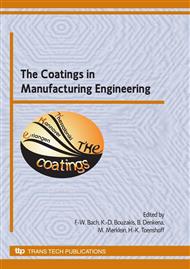p.49
p.57
p.65
p.73
p.81
p.89
p.97
p.107
p.115
Characterization of Heat Transfer Coefficients of Tool Materials and Tool Coatings for Hot Stamping of Boron-Manganese Steels
Abstract:
One characteristic of hot stamping of ultra high strength steels is the high wear rate of the used tools which leads to shorter tool life. Coatings improving wear resistance can increase the lifetime of the used tools but process relevant data such as the heat transfer capability of coated tool steels are missing. Within this paper the heat transfer capabilities of coated tool steels for the hot stamping processes are determined. Therefore different coating systems based on AlCrN are applied on the tool steels and the pressure dependent heat transfer coefficient is determined using process relevant conditions. As semi-finished blank the hot stamping steel 22MnB5 with an aluminum-silicon pre-coating is used. With respect to a finite element analysis of the forming operation of the hot stamping process the heat transfer coefficient represents an important input data for the process layout.
Info:
Periodical:
Pages:
81-88
Citation:
Online since:
May 2010
Authors:
Keywords:
Price:
Сopyright:
© 2010 Trans Tech Publications Ltd. All Rights Reserved
Share:
Citation:


